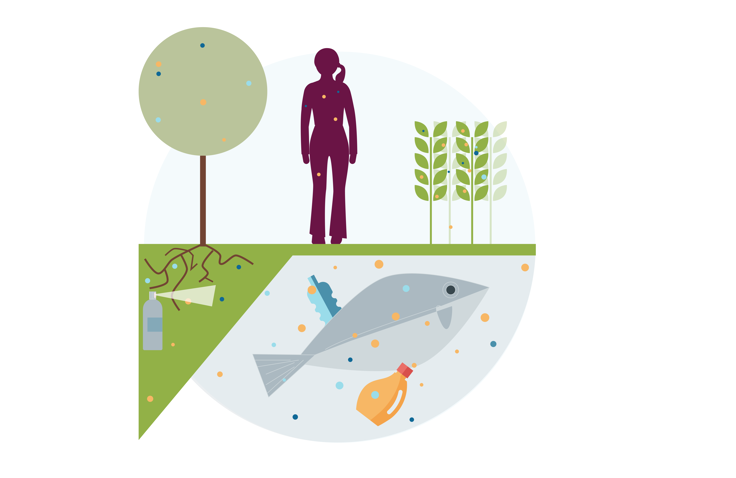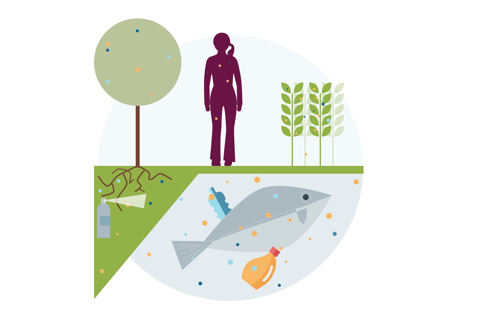About The Norwegian Environmental Biobank
Article
|Published
We are exposed daily to environmental contaminants; substances from air, food, water, and consumer products that can be harmful to our health. Environmental contaminants are considered one of the main threats to the health of future generations. The environmental biobank monitors how much of the relevant environmental contaminants and other unwanted substances we are exposed to and the extent to which these can increase the risk of health problems.
What is an environmental biobank?
In the Environmental Biobank, we collect blood and urine samples from people living in Norway. "Bio" indicates that the samples are biological, and "bank" means that the samples are stored. They are stored in small tubes and kept frozen over time and are made available for research and health surveillance.
Why is the Environmental Biobank important?
Environmental contaminants are one of the biggest threats to the health of future generations. With the help of information and biological samples collected by the Environmental Biobank, we can identify health threats at an early stage.
We hope that many of those who submit samples will continue to do so in the future. In this way, it is possible to monitor how levels of nutrients, environmental contaminants and other unwanted substances in our body change over time. If we find levels that are concerning, this should be followed up with political measures, and over time we can see if the measures have an effect.
Who submits samples?
In 2016, we invited about 9,000 mothers, fathers and children in the Norwegian Mother, Father and Child Cohort Study (MoBa) to submit samples and answer a questionnaire. About 1,800 people participated (around 660 mothers and their children, and 500 fathers).
In 2024, we will start a new round of sample collection for the Environmental Biobank, where we invite everyone who participated in the previous collection, as well as other families from MoBa (mother, father and child).
What are samples used for?
The Environmental Biobank studies trends over time, geographical differences, and variation between individuals. Samples and questionnaires collected for the Environmental Biobank are also used in studies that can contribute to more knowledge about:
- how we ingest environmental contaminants
- groups who are exposed to particularly large amounts of environmental contaminants
- new types of environmental contaminants that should be monitored
- associations between environmental contaminants and health
This knowledge can be used by the health authorities in health surveillance and is useful in connection with risk assessments of environmental contaminants. In addition, we can monitor whether the diet provides enough vitamins and minerals.
How have environmental biobanks had an impact on public health?
In the late 1970s, researchers found high levels of lead in blood samples collected in the USA. The findings could be directly linked to harmful effects to children’s health. Political measures were introduced to phase out lead in petrol. Today, blood lead levels have decreased in all countries that have introduced unleaded petrol.
Several of the Norwegian Institute of Public Health's studies on flame retardants and per- and polyfluoroalkyl substances (PFAS) have been used as the basis for the regulation of the use of such substances by European health authorities.
These examples show how the Environmental Biobank can become an important tool both in national and international work with the environment and health.
The Environmental Biobank - A time capsule with information about environmental contaminants and our health
Environmental contaminants are one of the main threats to the health of future generations and being able to detect these threats is therefore important. Samples from the Environmental Biobank can be used in ongoing projects, but most of the samples will be stored for a long time as time capsules for use in future analyses. In this way, we can learn more about environmental contaminants and their effects on our health over time. Development of new and more sensitive analytical methods will increase the value of the samples in the Environmental Biobank so it will be possible to perform improved and further analyses on previously collected samples.
How have samples collected in 2016-17 been used so far
A small proportion of the samples collected in 2016-17 from children have been used for analysis of several known environmental contaminants, but the main part of the sample will be stored for a long time as so-called "time capsules". The same will apply to the samples collected in 2024.
The environmental contaminants that have been analysed are:
- per- and polyfluoroalkyl substances (PFAS)
- polychlorinated biphenyls (PCBs)
- pesticides
- flame retardants
- phthalates
- bisphenols
- parabens
- acrylamide
The results from the analyses of these environmental contaminants are linked to data from the questionnaires that were completed at the same time as the samples were taken, as well as information from other MoBa questionnaires.
The results have been used in three research projects so far:
CATCHUP: A project funded by the Research Council of Norway that investigates whether exposure to cocktails of environmental contaminants in vulnerable life periods (pregnancy and early childhood) may impact growth, weight development and metabolic disorders in childhood.
NON-PROTECTED: A project funded by the Research Council of Norway that investigates whether the level of the environmental contaminants PFASs in the body may impact the development of antibodies after childhood vaccines, and the role of the intestinal microflora.
European Human Biomonitoring Initiative (HBM4EU): A project funded by the EU that, among other things, examines levels of several environmental contaminants in children and young people from several European countries. The Norwegian data are obtained from the Environmental Biobank.
Contact information
If you have any questions, contact us by e-mail: miljobiobank@fhi.no
If urgent, please call Project manager Line Småstuen Haug: +47 91 65 01 25.

